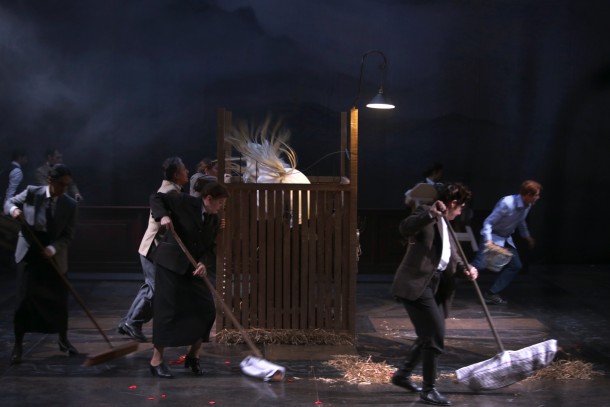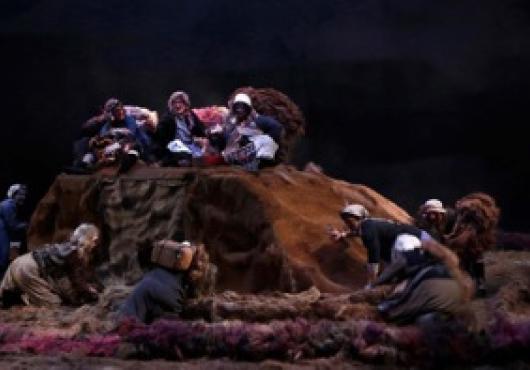The opening of any new production by Ariane Mnouchkine at her Théâtre de Soleil in Paris is an event of considerable significance in the European theatre, but her staging of Shakespeare’s Macbeth, which opened in May of 2014, came with particular anticipation. It marked the 50th anniversary of this remarkable company and was the first new production mounted in Mnouchkine in four years. Moreover, it returned to Shakespeare, inevitably recalling the revolutionary Oriental Shakespeares, among the best-known productions by the Soleil presented two decades ago.
Given the anticipation generated by this production, the result, though certainly ambitious, was something of a disappointment. Although the staging was visually rich, there was very little of the innovative work that has characterized much of the Soleil offerings. On the contrary, the production was distinctly ponderous and old-fashioned in its physical presentation. As is almost always the case with Mnouchkine, the ambitious staging dominated the production, but not in a positive way. Mnouchkine looks back to the English tradition of the late nineteenth century, when Shakespeare was staged with even small scenes presented in settings of detailed realism, generally achieved by extensive use of elevator stages, sliding stages, and such elaborate machinery. The Soleil lacking such equipment, Mnouchkine achieves a similar effect by much simpler means. The large performance area has no walls or ceiling but is surrounded by neutral hangings. After each of the 24 scenes, these are opened by ropes and the entire company swarms onto the stage (they number 42 in all, the largest cast of any production Mnouchkine has ever staged), removing all the detailed realistic items of the previous setting and replacing it by a new setting with similar elaborate detail, creating rich salons, a sprawling roserie, ballrooms and reception rooms, battlefields and bucolic countrysides, all devoid of scenic backgrounds, but otherwise complete in detailed realism, including rich carpets in every interior and other appropriate floor coverings—straw, rose petals, grass and weeds—for other spaces. The spectacle of dozens of carefully choreographed bodies, some in costume, others not, placing furniture and set details, unrolling rugs and sweeping the floor, at impressive speed, is fascinating for the first six or seven such changes, but as the hours pass, the convention calls attention to itself and to the disruption it constantly offers to the rhythm of the play itself (not to mention its length, which with all this added activity runs to nearly four hours).
Although the interior scenes in particular are elegant, even spectacular (the banquet scene, set in a 1930s style ballroom with individual tables on spinning disks is one striking example), just what all this visual display contributes to a reading of the play is not at all clear. Why, one may wonder, does Lady Macbeth welcome her husband home in a huge and elaborate roserie, filled with gardeners, attendants and plants, or even more oddly, why do she and Macbeth plot the murder in what is clearly a stable, with straw on the floor and between two stalls each of which contains a large, live horse? The setting is more or less contemporary, although contemporary is very vaguely defined. Clearly the first scene, on the battlefield, has a World War I setting, with Duncan receiving information on primitive field telephones, but Macbeth and Banquo as returning heroes are airlifted to a press-conference audience with Duncan by helicopter, and Macbeth as king spends his evening watching DVDs and communicates by text messages. The exiled Malcolm, in London, discusses the plight of Scotland under Macbeth with his companions on a balcony overlooking the city while the contemporary giant ferris wheel, The London Eye, turns distractingly in the distance. The recent death of Mnouchkine’s long-time scenic designer, Guy-Claude François, may explain the occasional lapses of judgment in what is overall a striking but not really successful design approach. Interestingly, no specific scene designer is cited for the production, although Mnouchkine’s long-time innovative music designer, Jean-Jacque Lemêtre, is credited with the sound.
When Macduff finally comes to challenge Macbeth, he must open the top of a bizarre, rolling, primitive, tank-like straw box in which the dictator has taken refuge. The box clearly is meant to resemble a realistic haystack upon which the rural witches revel in their opening scene, but what it has to do with twentieth century warfare is quite inexplicable. It is also, most unusual for Mnouchkine, visually strikingly ugly as well as inappropriate.
When Mnouchkine did her most famous classic updating, of Tartuffe, she was to use this technique to stress a particular message about religious fundamentalism. The updated Macbeth, she has suggested, seeks a similar contemporary relevance by pointing out the similarities of the not particularly gifted men who seize and abuse power in all periods. While one can hardly disagree with this observation, it hardly seems necessary to provide Shakespeare’s play with a hodge-podge of twentieth and twenty-first century costumes and settings to achieve it.
So overwhelming are the production’s visual effects that individual actors make comparatively little impact. Serge Niolaï as Macbeth is the only member of the company to play a single role, but the production’s choice to present him as representing “the banality” of evil leaves him often with little real impact on the stage. He is generally overshadowed by the much more flamboyant, jeans-wearing Nrupama Nituananda, a long-time veteran of the company. Among the other actors, the most consistently effective is probably Duccio Bellugi-Vannuccini, who provides in Malcolm the dignity and depth often lacking in Macbeth.
As always, the audience enters the theatre through a lavishly decorated reception chamber, with walls covered with images of the playwright and play and with dispensers of suggestive suitable food including, just inside the front door, an attractive gingerbread cart. All the traditional trappings of the Soleil are present and most of the press, long accustomed to viewing Mnouchkine as a national treasure, were on the whole full of praise, but as a long-time aficionado of this theatre, I found this latest production, while full of sound and spectacle, decidedly secondary in emotional or intellectual impact.
, Sidney E. Cohn Professor of Theatre at the City University of New York Graduate Center, is the author of many articles on theatrical theory and European theatre history, and dramatic literature. He is the 1994 recipient of the George Jean Nathan Award for dramatic criticism and the 1999 recipient of the American Society for Theatre Research Distinguished Scholar Award. His book The Haunted Stage: The Theatre as Memory Machine, which came out from University of Michigan Press in 2001, received the Callaway Prize. In 2005 he received an honorary doctorate from the University of Athens. His most recent book is The Theatres of Morocco, Algeria and Tunisia with Khalid Amine (Palgrave, 2012).
European Stages, vol. 4, no. 1 (Spring 2015)
Editorial Board:
Marvin Carlson, Senior Editor, Founder
Krystyna Illakowicz, Co-Editor
Dominika Laster, Co-Editor
Editorial Staff:
Elizabeth Hickman, Managing Editor
Bhargav Rani, Editorial Assistant
Advisory Board:
Joshua Abrams
Christopher Balme
Maria Delgado
Allen Kuharsky
Jennifer Parker-Starbuck
Magda Romańska
Laurence Senelick
Daniele Vianello
Phyllis Zatlin
Table of Contents:
- Report from Berlin by Yvonne Shafer
- Performing Protest/Protesting Performance: Golgota Picnic in Warsaw by Chris Rzonca
- A Mad World My Masters at the Barbican by Marvin Carlson
- Grief, Family, Politics, but no Passion: Ivo van Hove’s Antigone by Erik Abbott
- Not Not I: Undoing Representation with Dead Centre’s Lippy by Daniel Sack
- In the Name of Our Peasants: History and Identity in Ukrainian and Polish Contemporary Theatre by Oksana Dudko
- Performances at a Symposium: “Theatre as a Laboratory for Community Interaction” at Odin Teatret, Holstebro, Denmark, May, 2014 by Seth Baumrin
- Songs of Lear by the Polish Song of the Goat Theatre by Lauren Dubowski
- Silence, Shakespeare and the Art of Taking Sides, Report from Barcelona by Maria M. Delgado
- Little Theatres and Small Casts: Madrid Stage in October 2014 by Phyllis Zatlin
- Gobrowicz’s and Ronconi’s Pornography without Scandal by Daniele Vianello
- Majster a Margaréta in Teatro Tatro, Slovakia by Miroslav Ballay
- Remnants of the Welfare State: A Community of Humans and Other Animals on the Main Stage of the Finnish National Theatre by Outi Lahtinen
- Mnouchkine’s Macbeth at the Cartoucherie by Marvin Carlson
- Awantura Warszawska and History in the Making: Michał Zadara’s Docudrama, Warsaw Uprising Museum, August, 2011 by Krystyna Illakowicz and Chris Rzonca
Martin E. Segal Theatre Center:
Frank Hentschker, Executive Director
Marvin Carlson, Director of Publications
Rebecca Sheahan, Managing Director
©2015 by Martin E. Segal Theatre Center
The Graduate Center CUNY Graduate Center
365 Fifth Avenue
New York NY 10016





